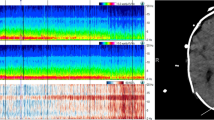Abstract
For the diagnosis of electrographic seizures or status epilepticus, we reduced the number of EEG-electrodes to make urgent EEG monitoring more feasible. Unlike the current existing research, with mixed results, we studied a specific population with postanoxic brain damage, expecting a higher yield of detection of ictal EEG patterns. In a population treated with therapeutic hypothermia post-cardiac arrest, the initial EEGs were reformatted in a longitudinal, a hairline and an 8-lead montage, and independently reviewed by two investigators. The EEGs were categorized into three categories: one without ictal EEG activity, one with interictal activity and one with probable electrographic seizure(s). Generalized ictal EEG activity was the most frequently observed EEG pattern. The average sensitivity for the detection of probable electrographic seizure(s) was 100 % for the 8-lead montage and 92 % in the hairline montage. In comparison to the routine longitudinal montage, the 8-lead montage proved to be reliable for the detection of electrographic seizure activity in a postanoxic population even with limited training in EEG interpretation. The hairline montage did not suffice with regard to the differential diagnosis of triphasic waves associated with metabolic encephalopathy and generalized nonconvulsive status epilepticus, but nonetheless detected the vast majority of probable electrographic seizure(s). Our results support the use of EEG monitoring with fewer electrodes for the detection of ictal EEG activity in the postanoxic population.




Similar content being viewed by others
References
Geri G, Mongardon N, Daviaud F et al (2014) Neurological consequences of cardiac arrest: where do we stand? Ann Fr Anesth Reanim 33:98–101. doi:10.1016/j.annfar.2013.11.003
Fugate JE, Wijdicks EFM, Mandrekar J et al (2010) Predictors of neurologic outcome in hypothermia after cardiac arrest. Ann Neurol 68:907–914. doi:10.1002/ana.22133
Bernard SA, Gray TW, Buist MD et al (2002) Treatment of comatose survivors of out-of-hospital cardiac arrest with induced hypothermia. N Engl J Med. doi:10.1056/NEJMoa003289
Hypothermia after Cardiac Arrest Study Group, Group HACAS (2002) Mild therapeutic hypothermia to improve the neurologic outcome after cardiac arrest. N Engl J Med 346:549–556. doi:10.1056/NEJMoa012689
Nielsen N, Wetterslev J, Cronberg T et al (2013) Targeted temperature management at 33 °C versus 36 °C after cardiac arrest. N Engl J Med 369:2197–2206. doi:10.1056/NEJMoa1310519
Peberdy MA, Callaway CW, Neumar RW et al (2010) Part 9: post-cardiac arrest care: 2010 American Heart Association Guidelines for Cardiopulmonary Resuscitation and Emergency Cardiovascular Care. Circulation 122:S768–S786. doi:10.1161/CIRCULATIONAHA.110.971002
Hofmeijer J, Tjepkema-Cloostermans MC, Blans MJ et al (2014) Unstandardized treatment of electroencephalographic status epilepticus does not improve outcome of comatose patients after cardiac arrest. Front Neurol 5:39. doi:10.3389/fneur.2014.00039
Rittenberger JC, Popescu A, Brenner RP et al (2012) Frequency and timing of nonconvulsive status epilepticus in comatose post-cardiac arrest subjects treated with hypothermia. Neurocrit Care 16:114–122. doi:10.1007/s12028-011-9565-0
Rossetti AO, Logroscino G, Liaudet L et al (2007) Status epilepticus: an independent outcome predictor after cerebral anoxia. Neurology 69:255–260. doi:10.1212/01.wnl.0000265819.36639.e0
Tjepkema-Cloostermans MC, Hofmeijer J, Trof RJ et al (2015) Electroencephalogram predicts outcome in patients with postanoxic coma during mild therapeutic hypothermia. Crit Care Med 43:159–167. doi:10.1097/CCM.0000000000000626
Rossetti AO, Oddo M, Liaudet L, Kaplan PW (2009) Predictors of awakening from postanoxic status epilepticus after therapeutic hypothermia. Neurology 72:744–749. doi:10.1212/01.wnl.0000343006.60851.62
Young GB, Sharpe MD, Savard M et al (2009) Seizure detection with a commercially available bedside EEG monitor and the subhairline montage. Neurocrit Care 11:411–416. doi:10.1007/s12028-009-9248-2
Kolls BJ, Husain AM (2007) Assessment of hairline EEG as a screening tool for nonconvulsive status epilepticus. Epilepsia 48:959–965. doi:10.1111/j.1528-1167.2007.01078.x
Friberg H, Westhall E, Rosén I et al (2013) Clinical review: continuous and simplified electroencephalography to monitor brain recovery after cardiac arrest. Crit Care. doi:10.1186/cc12699
Rubin MN, Jeffery OJ, Fugate JE et al (2014) Efficacy of a reduced electroencephalography electrode array for detection of seizures. Neurohospitalist 4:6–8. doi:10.1177/1941874413507930
Karakis I, Montouris GD, Otis JAD et al (2010) A quick and reliable EEG montage for the detection of seizures in the critical care setting. J Clin Neurophysiol 27:100–105
Tanner AEJ, Särkelä MOK, Virtanen J et al (2014) Application of subhairline EEG montage in intensive care unit: comparison with full montage. J Clin Neurophysiol 31:181–186. doi:10.1097/WNP.0000000000000049
American Electroencephalographic Society (1994) Guideline thirteen: guidelines for standard electrode position nomenclature. J Clin Neurophysiol 11:111–113
Boulanger J-M, Deacon C, Lécuyer D et al (2006) Triphasic waves versus nonconvulsive status epilepticus: EEG distinction. Can J Neurol Sci. doi:10.1111/acem.12338
Knight WA, Hart KW, Adeoye OM et al (2013) The incidence of seizures in patients undergoing therapeutic hypothermia after resuscitation from cardiac arrest. Epilepsy Res 106:396–402. doi:10.1016/j.eplepsyres.2013.06.018
Beniczky S, Hirsch LJ, Kaplan PW et al (2013) Unified EEG terminology and criteria for nonconvulsive status epilepticus. Epilepsia 54:28–29. doi:10.1111/epi.12270
Hofmeijer J, Beernink TMJ, Bosch FH et al (2015) Early EEG contributes to multimodal outcome prediction of postanoxic coma. Neurology 85:137–143. doi:10.1212/WNL.0000000000001742
Freeman WD, Barrett KM, Freeman ML et al (2009) Predictors of awakening from postanoxic status epilepticus after therapeutic hypothermia. Neurology 73:1512. doi:10.1212/WNL.0b013e3181bd6923 (author reply 1512–3)
Legriel S, Bruneel F, Sediri H et al (2009) Early EEG monitoring for detecting postanoxic status epilepticus during therapeutic hypothermia: a pilot study. Neurocrit Care 11:338–344. doi:10.1007/s12028-009-9246-4
Mani R, Schmitt SE, Mazer M et al (2012) The frequency and timing of epileptiform activity on continuous electroencephalogram in comatose post-cardiac arrest syndrome patients treated with therapeutic hypothermia. Resuscitation 83:840–847. doi:10.1016/j.resuscitation.2012.02.015
Rossetti AO (2011) What is the value of hypothermia in acute neurologic diseases and status epilepticus? Epilepsia 52:64–66. doi:10.1111/j.1528-1167.2011.03241.x
Author information
Authors and Affiliations
Corresponding author
Ethics declarations
Conflict of interest
The authors declare that there is no conflict of interest.
Ethical approval
Ethical approval for this retrospective medical record review was received from the University Hospitals Leuven’s Medical ethical committee.
Informed consent
This study concerns a retrospective medical record review and does not contain any potentially identifying information.
Funding
This research received no specific grant from any funding agency in the public, commercial, or not-for-profit sectors.
Rights and permissions
About this article
Cite this article
Vanherpe, P., Schrooten, M. Minimal EEG montage with high yield for the detection of status epilepticus in the setting of postanoxic brain damage. Acta Neurol Belg 117, 145–152 (2017). https://doi.org/10.1007/s13760-016-0663-9
Received:
Accepted:
Published:
Issue Date:
DOI: https://doi.org/10.1007/s13760-016-0663-9




